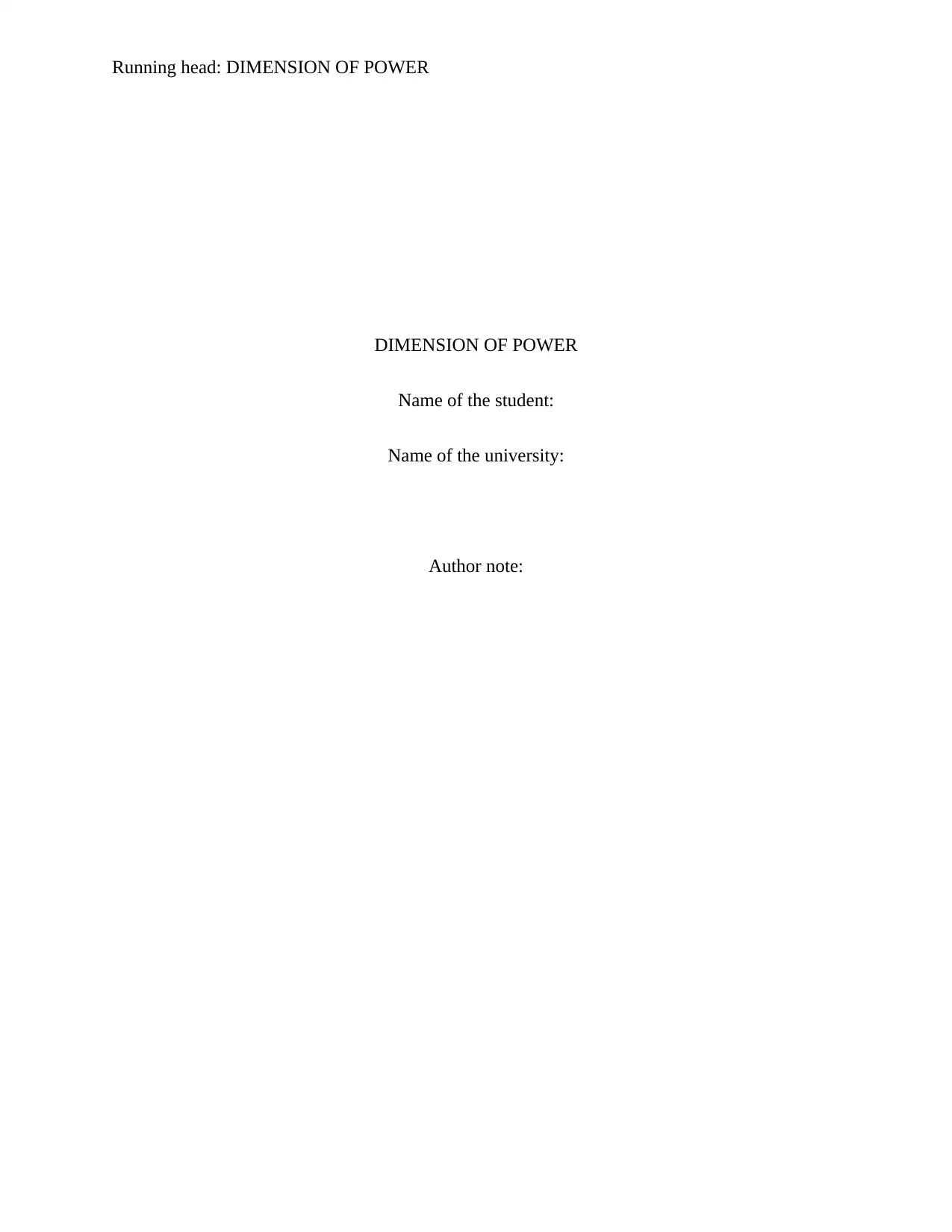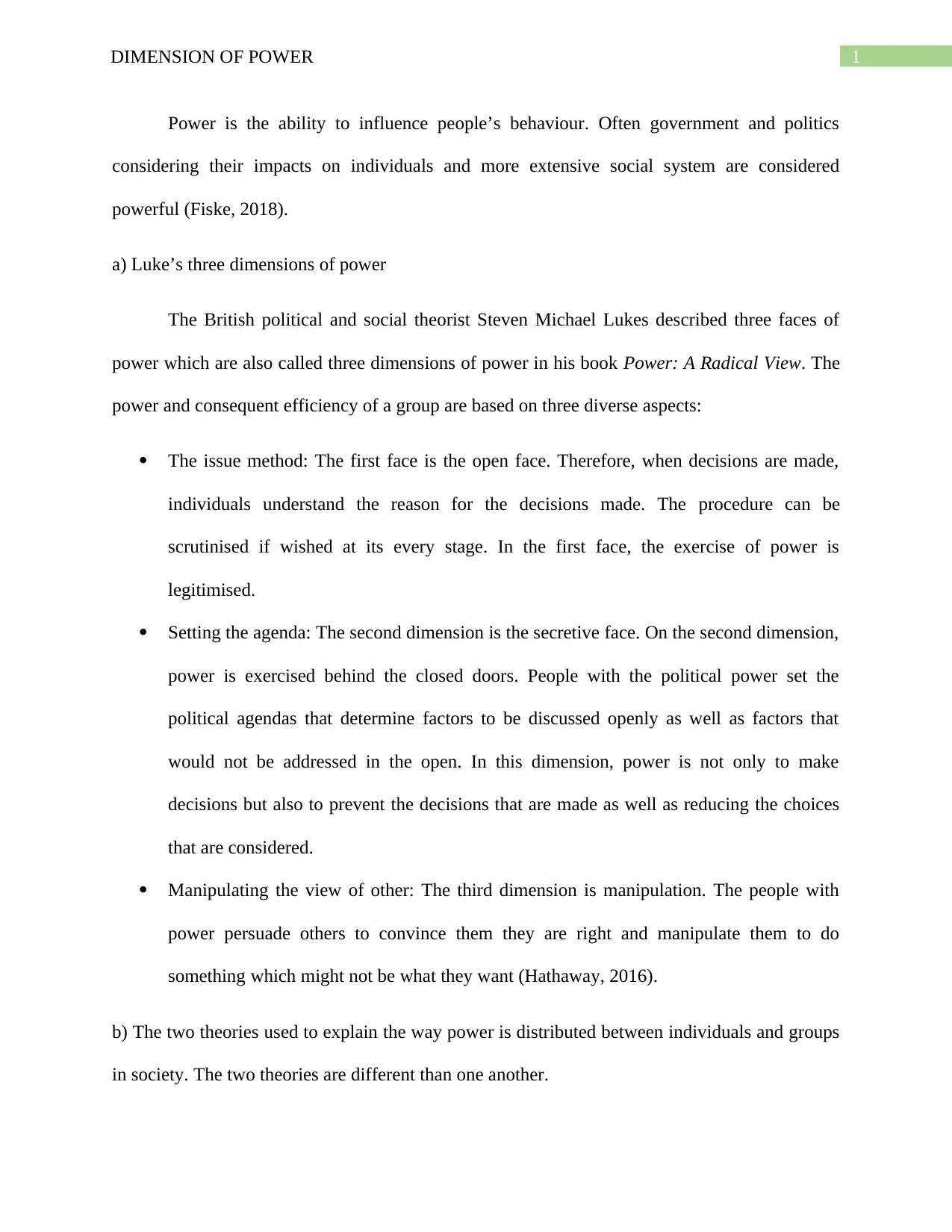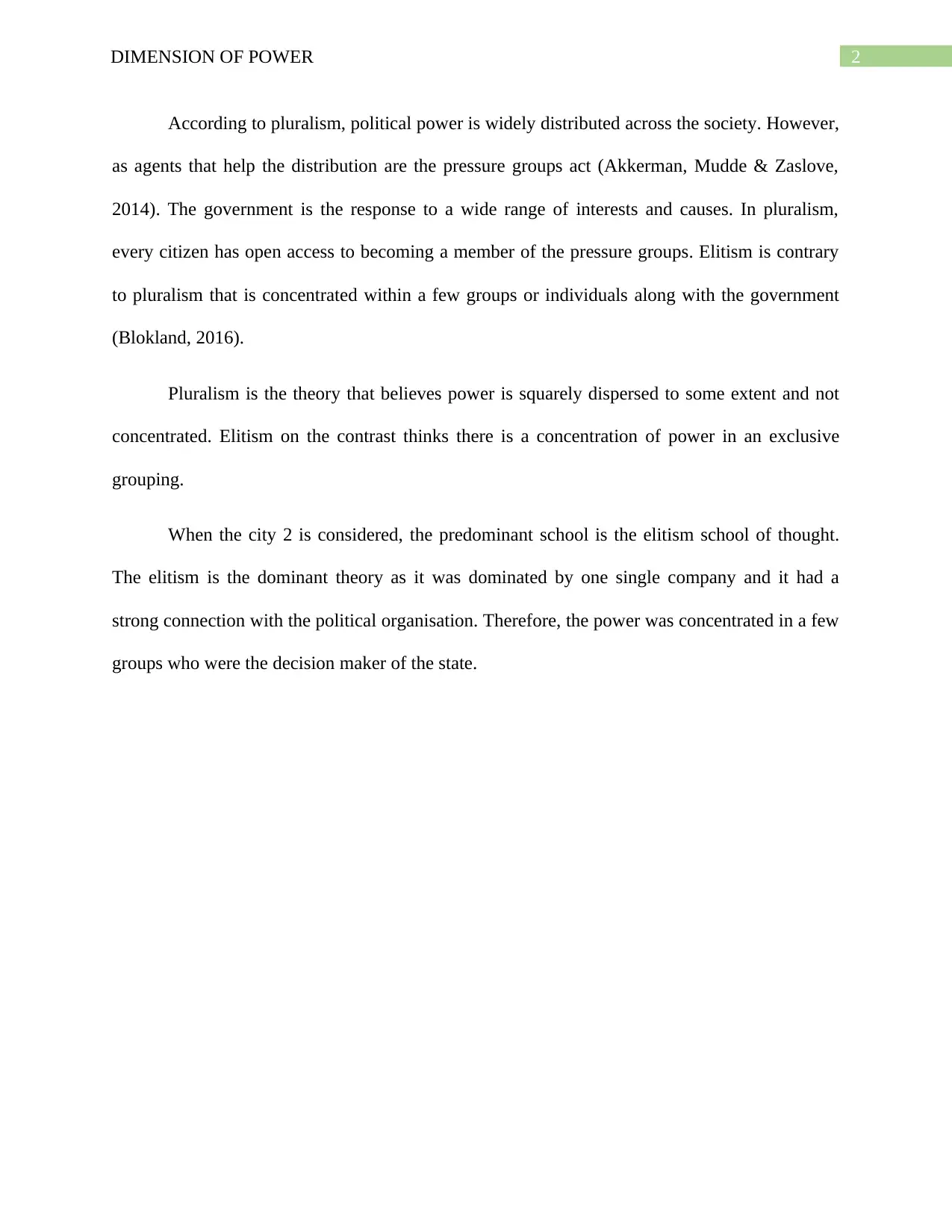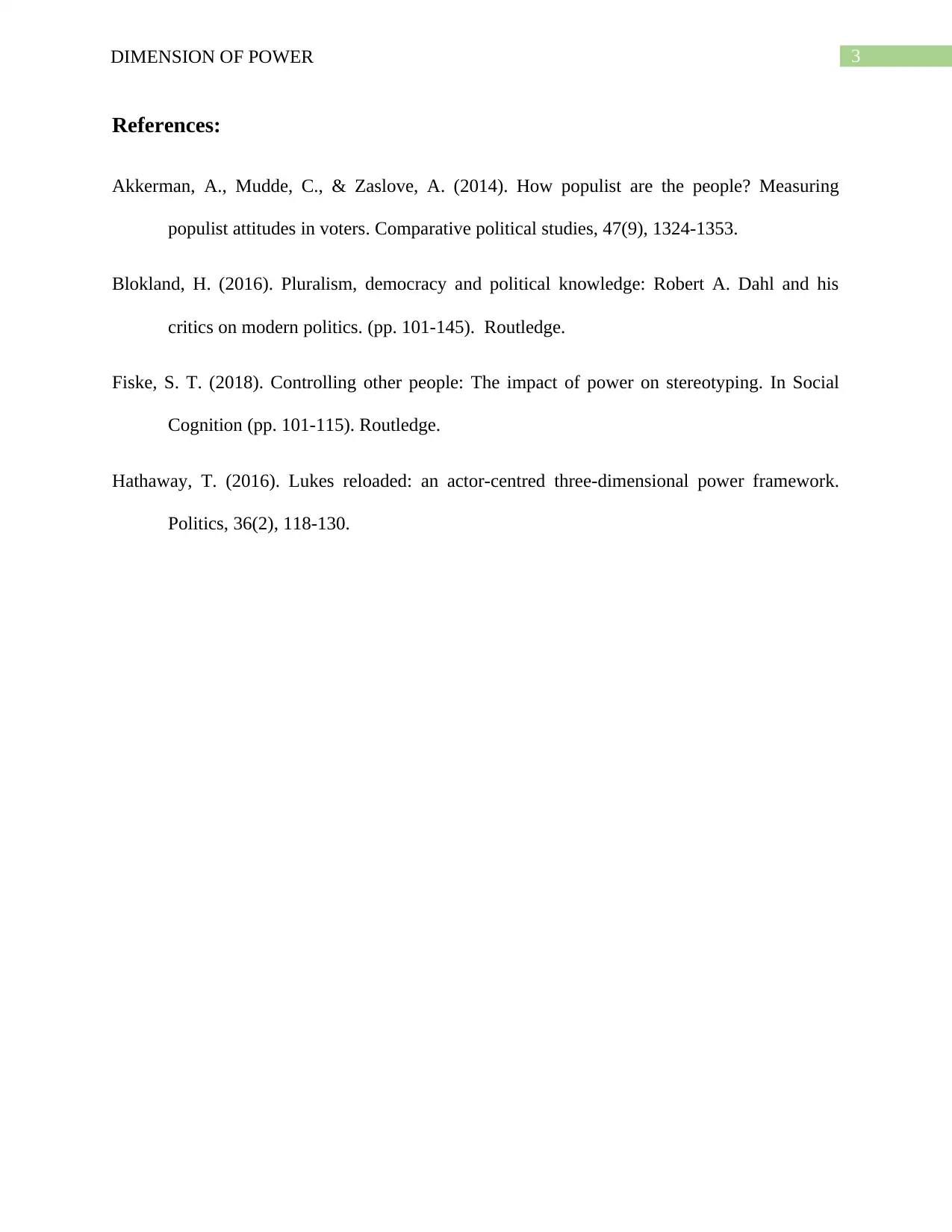Lukes' Dimensions of Power and Theories of Power Distribution Analysis
VerifiedAdded on 2023/05/31
|4
|648
|249
Essay
AI Summary
This essay delves into Steven Lukes' three dimensions of power, which include the issue method, setting the agenda, and manipulating the views of others. It further explores two contrasting theories on how power is distributed in society: pluralism, which posits that power is widely distributed through p...

Running head: DIMENSION OF POWER
DIMENSION OF POWER
Name of the student:
Name of the university:
Author note:
DIMENSION OF POWER
Name of the student:
Name of the university:
Author note:
Paraphrase This Document
Need a fresh take? Get an instant paraphrase of this document with our AI Paraphraser

1DIMENSION OF POWER
Power is the ability to influence people’s behaviour. Often government and politics
considering their impacts on individuals and more extensive social system are considered
powerful (Fiske, 2018).
a) Luke’s three dimensions of power
The British political and social theorist Steven Michael Lukes described three faces of
power which are also called three dimensions of power in his book Power: A Radical View. The
power and consequent efficiency of a group are based on three diverse aspects:
The issue method: The first face is the open face. Therefore, when decisions are made,
individuals understand the reason for the decisions made. The procedure can be
scrutinised if wished at its every stage. In the first face, the exercise of power is
legitimised.
Setting the agenda: The second dimension is the secretive face. On the second dimension,
power is exercised behind the closed doors. People with the political power set the
political agendas that determine factors to be discussed openly as well as factors that
would not be addressed in the open. In this dimension, power is not only to make
decisions but also to prevent the decisions that are made as well as reducing the choices
that are considered.
Manipulating the view of other: The third dimension is manipulation. The people with
power persuade others to convince them they are right and manipulate them to do
something which might not be what they want (Hathaway, 2016).
b) The two theories used to explain the way power is distributed between individuals and groups
in society. The two theories are different than one another.
Power is the ability to influence people’s behaviour. Often government and politics
considering their impacts on individuals and more extensive social system are considered
powerful (Fiske, 2018).
a) Luke’s three dimensions of power
The British political and social theorist Steven Michael Lukes described three faces of
power which are also called three dimensions of power in his book Power: A Radical View. The
power and consequent efficiency of a group are based on three diverse aspects:
The issue method: The first face is the open face. Therefore, when decisions are made,
individuals understand the reason for the decisions made. The procedure can be
scrutinised if wished at its every stage. In the first face, the exercise of power is
legitimised.
Setting the agenda: The second dimension is the secretive face. On the second dimension,
power is exercised behind the closed doors. People with the political power set the
political agendas that determine factors to be discussed openly as well as factors that
would not be addressed in the open. In this dimension, power is not only to make
decisions but also to prevent the decisions that are made as well as reducing the choices
that are considered.
Manipulating the view of other: The third dimension is manipulation. The people with
power persuade others to convince them they are right and manipulate them to do
something which might not be what they want (Hathaway, 2016).
b) The two theories used to explain the way power is distributed between individuals and groups
in society. The two theories are different than one another.

2DIMENSION OF POWER
According to pluralism, political power is widely distributed across the society. However,
as agents that help the distribution are the pressure groups act (Akkerman, Mudde & Zaslove,
2014). The government is the response to a wide range of interests and causes. In pluralism,
every citizen has open access to becoming a member of the pressure groups. Elitism is contrary
to pluralism that is concentrated within a few groups or individuals along with the government
(Blokland, 2016).
Pluralism is the theory that believes power is squarely dispersed to some extent and not
concentrated. Elitism on the contrast thinks there is a concentration of power in an exclusive
grouping.
When the city 2 is considered, the predominant school is the elitism school of thought.
The elitism is the dominant theory as it was dominated by one single company and it had a
strong connection with the political organisation. Therefore, the power was concentrated in a few
groups who were the decision maker of the state.
According to pluralism, political power is widely distributed across the society. However,
as agents that help the distribution are the pressure groups act (Akkerman, Mudde & Zaslove,
2014). The government is the response to a wide range of interests and causes. In pluralism,
every citizen has open access to becoming a member of the pressure groups. Elitism is contrary
to pluralism that is concentrated within a few groups or individuals along with the government
(Blokland, 2016).
Pluralism is the theory that believes power is squarely dispersed to some extent and not
concentrated. Elitism on the contrast thinks there is a concentration of power in an exclusive
grouping.
When the city 2 is considered, the predominant school is the elitism school of thought.
The elitism is the dominant theory as it was dominated by one single company and it had a
strong connection with the political organisation. Therefore, the power was concentrated in a few
groups who were the decision maker of the state.
⊘ This is a preview!⊘
Do you want full access?
Subscribe today to unlock all pages.

Trusted by 1+ million students worldwide

3DIMENSION OF POWER
References:
Akkerman, A., Mudde, C., & Zaslove, A. (2014). How populist are the people? Measuring
populist attitudes in voters. Comparative political studies, 47(9), 1324-1353.
Blokland, H. (2016). Pluralism, democracy and political knowledge: Robert A. Dahl and his
critics on modern politics. (pp. 101-145). Routledge.
Fiske, S. T. (2018). Controlling other people: The impact of power on stereotyping. In Social
Cognition (pp. 101-115). Routledge.
Hathaway, T. (2016). Lukes reloaded: an actor-centred three-dimensional power framework.
Politics, 36(2), 118-130.
References:
Akkerman, A., Mudde, C., & Zaslove, A. (2014). How populist are the people? Measuring
populist attitudes in voters. Comparative political studies, 47(9), 1324-1353.
Blokland, H. (2016). Pluralism, democracy and political knowledge: Robert A. Dahl and his
critics on modern politics. (pp. 101-145). Routledge.
Fiske, S. T. (2018). Controlling other people: The impact of power on stereotyping. In Social
Cognition (pp. 101-115). Routledge.
Hathaway, T. (2016). Lukes reloaded: an actor-centred three-dimensional power framework.
Politics, 36(2), 118-130.
1 out of 4
Your All-in-One AI-Powered Toolkit for Academic Success.
+13062052269
info@desklib.com
Available 24*7 on WhatsApp / Email
![[object Object]](/_next/static/media/star-bottom.7253800d.svg)
Unlock your academic potential
© 2024 | Zucol Services PVT LTD | All rights reserved.
